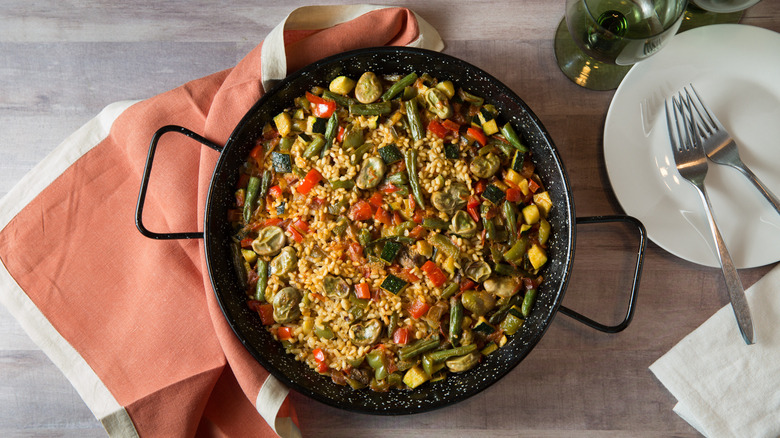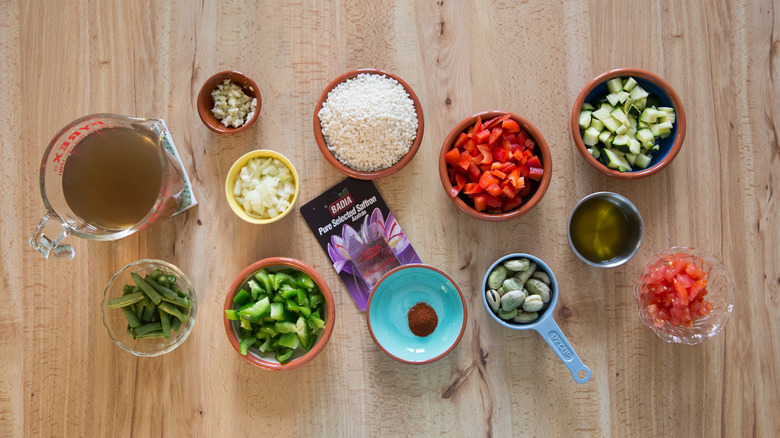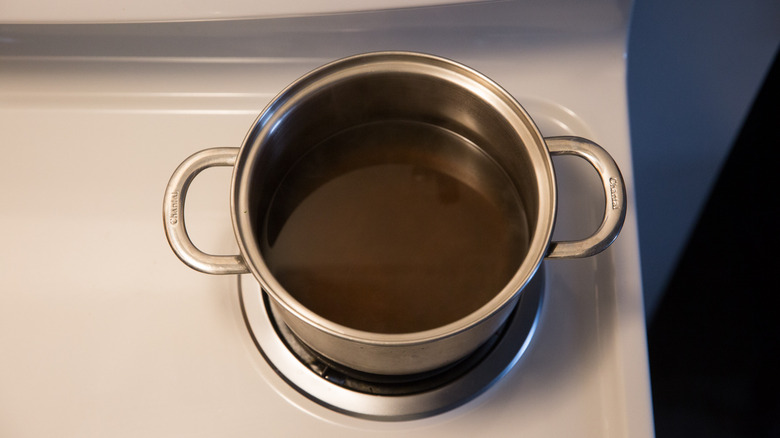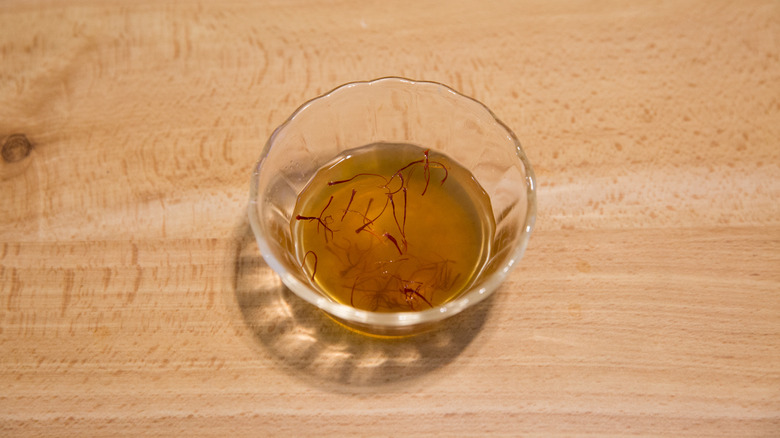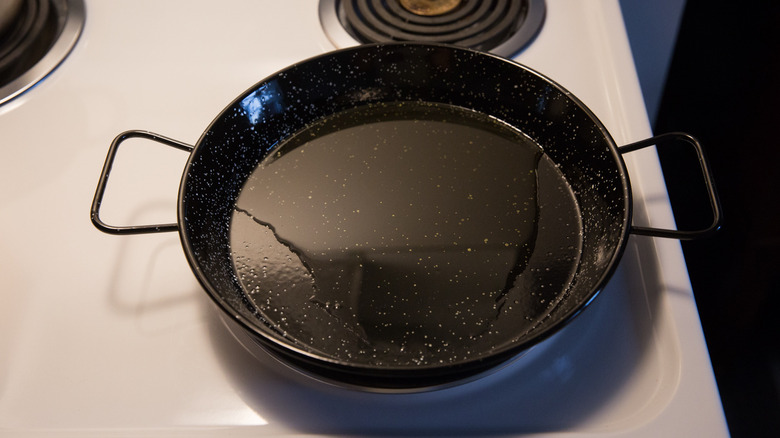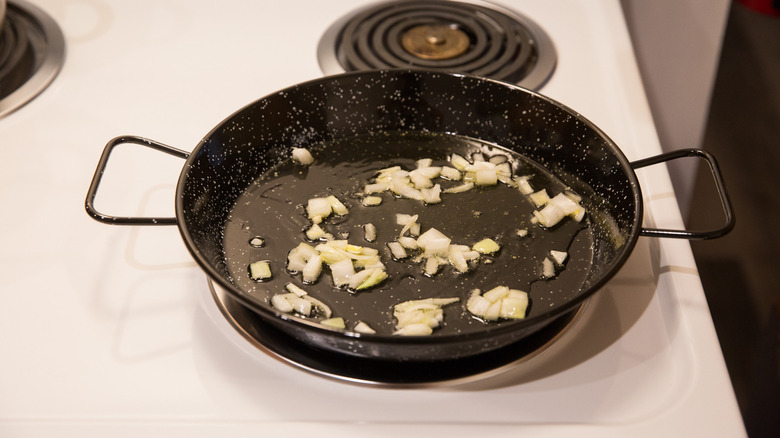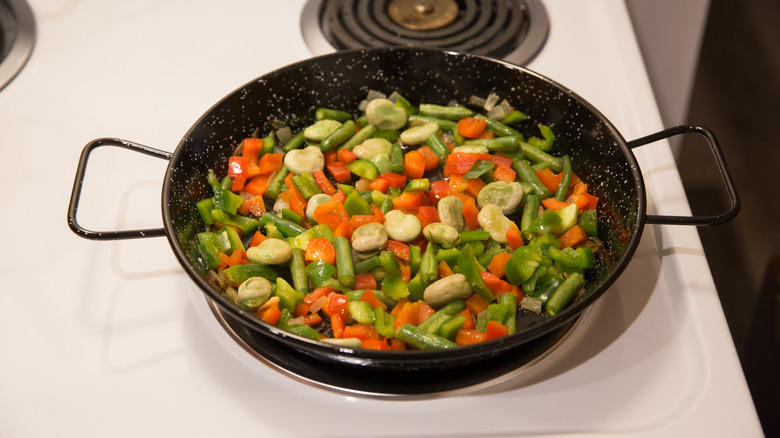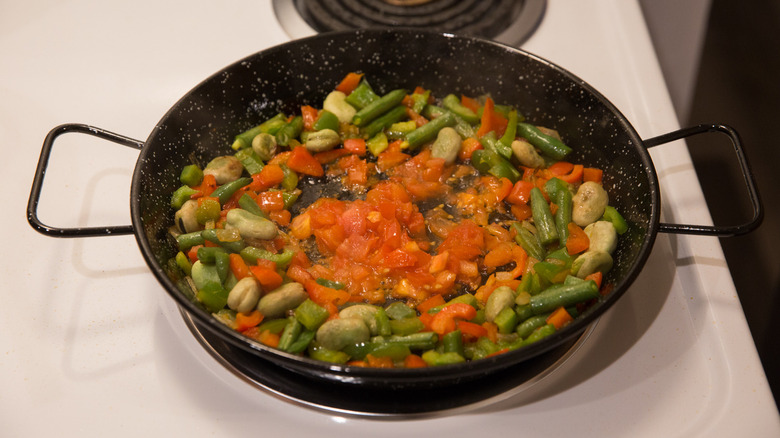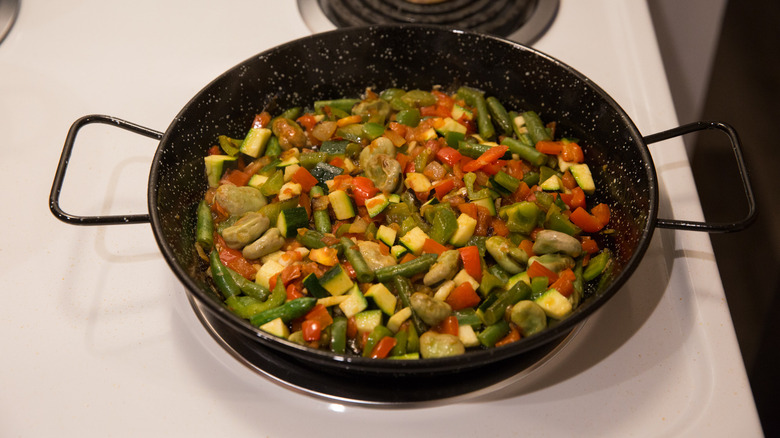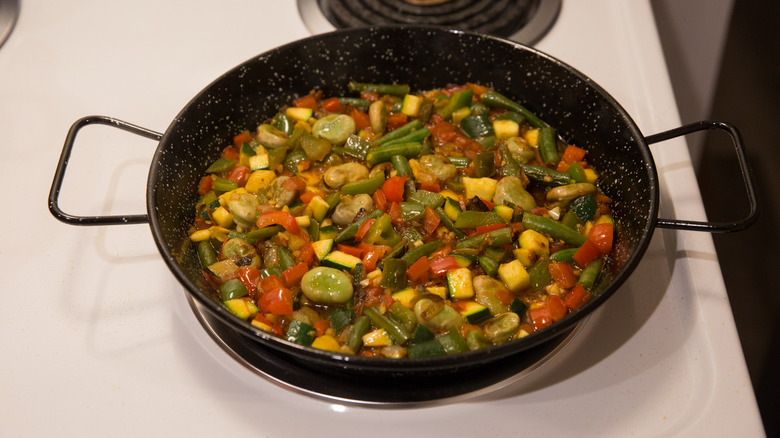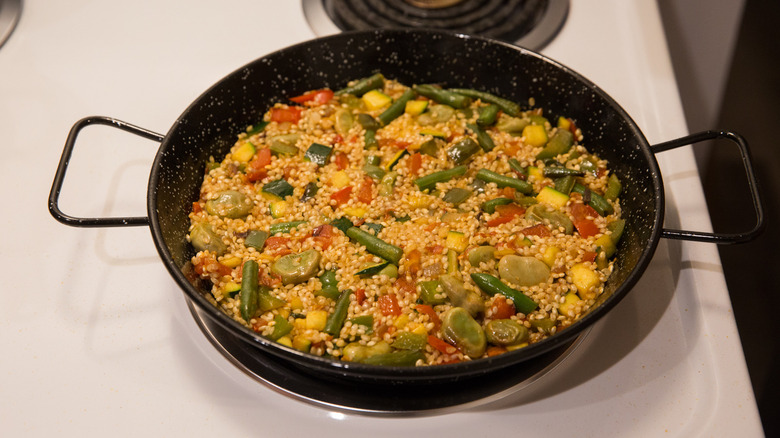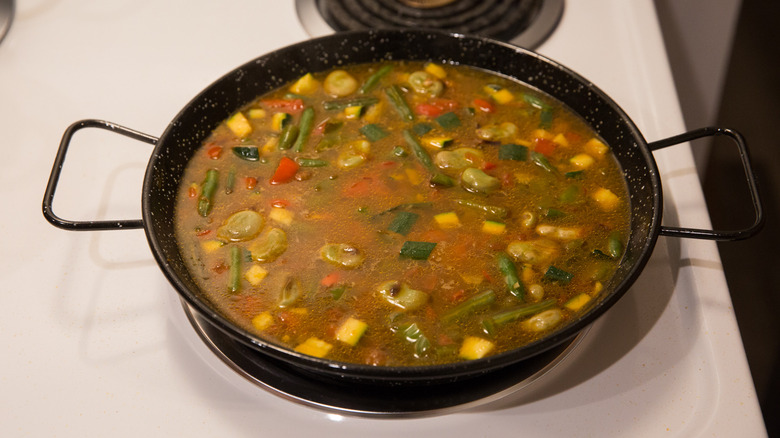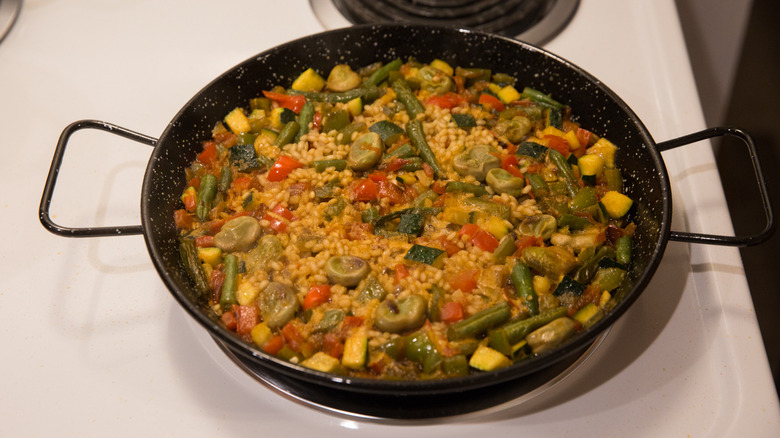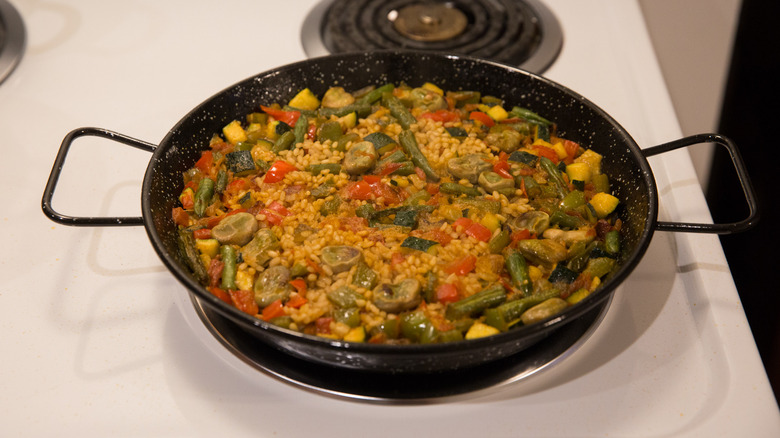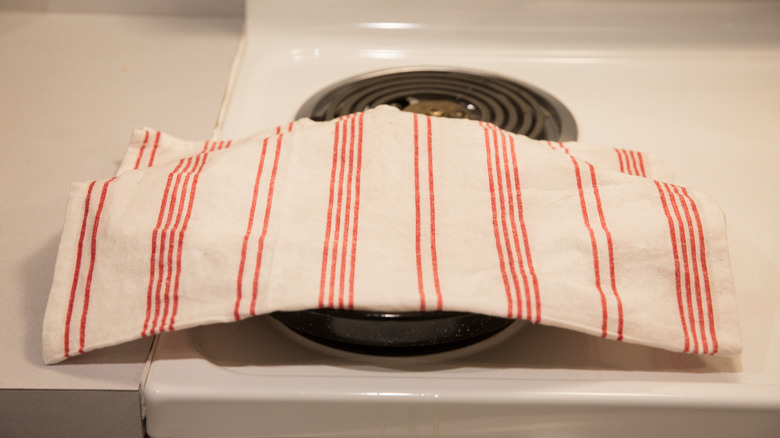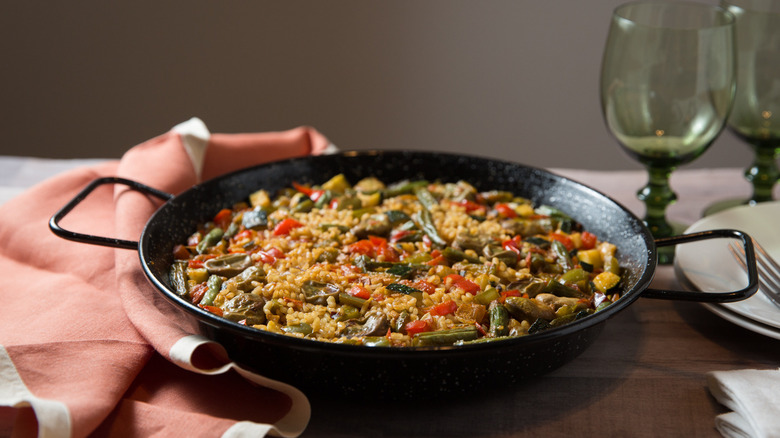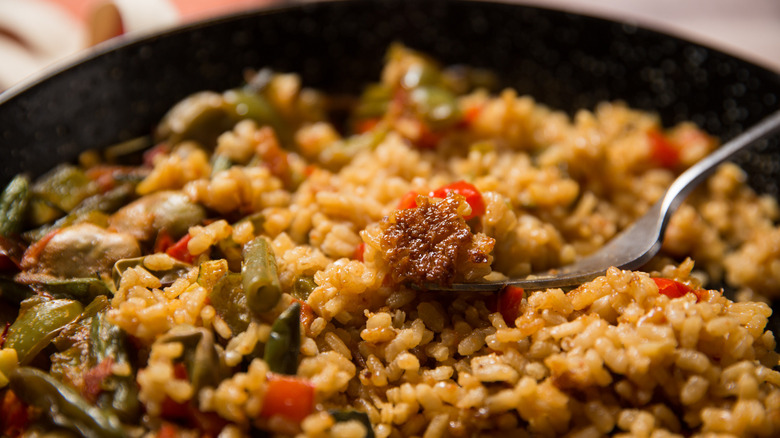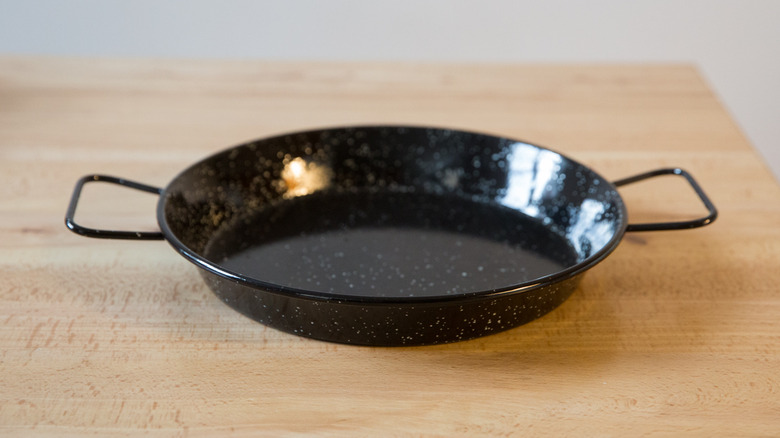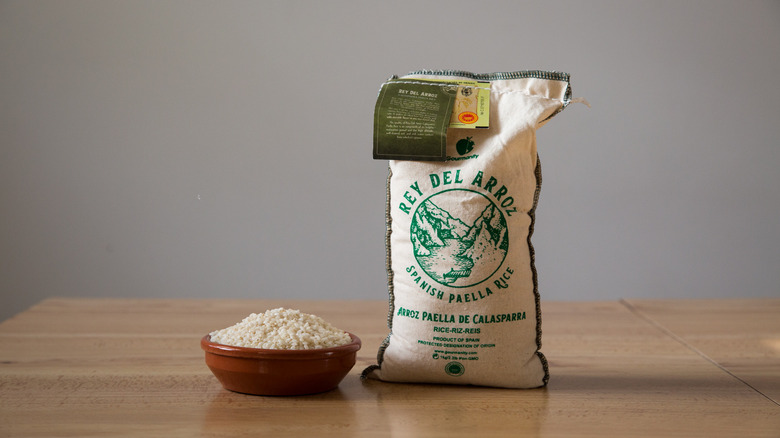Vegan Paella De Verduras Recipe
Paella is a Spanish rice dish and one of the most popular Spanish foods. It's also well-known outside of Spain. Traditionally, paella is made from round, short-grain rice grown in Valencia, a Spanish region famous for growing rice, and cooked over a wood fire. This dish can contain different combinations of meat, seafood, and vegetables, and its characteristic, yellow color comes from the addition of saffron, a special paella ingredient. Notwithstanding the delicious ingredients, many say the best part of paella is the socarrat, the scrumptious, crispy, rich, and caramelized crust that forms on the bottom toward the end of the cooking time. It just wouldn't be paella without it.
Recipe developer Michelle Bottalico has created a recipe for a vegetable paella, or "paella de verduras" in Spanish, that is entirely plant-based. Anyone can enjoy this delicious and healthy version of paella, which is loaded with bell pepper, green beans, fava beans, tomato, and zucchini, along with aromatics, spices, and flavorful vegetable broth. Paella is cooked and served in a special pan that is also called a paella. If you have one, you'll get the best results. You don't have to miss out on this special recipe if you don't. A wide, shallow skillet or saute pan can be substituted if needed, so don't miss out on trying to make this irresistible Spanish dish at home.
Gather your vegan paella de verduras ingredients
For this recipe, you will need yellow onion, green bell pepper, red bell pepper, green beans, fava beans or peas, tomato, zucchini, and garlic. It's okay to use different vegetables if they're similar and you keep the quantities about the same. For example, lima beans or shelled edamame could be used if fava beans or peas aren't available. You'll need vegetable broth and extra virgin olive oil, too.
Saffron threads give the paella a special flavor, and the other spice used is paprika. Lastly, make sure you use short-grain rice meant for paella, such as Spanish bomba or Calasparra rice. If those aren't available in your area, you can use Italian risotto rice like Arborio or Carnaroli, Japanese sushi rice, or a variety of rice grown in California called Calrose, which are all short-grain.
Step 1: Heat the broth
Pour the broth into a medium saucepan and bring it to a boil. As soon as it boils, lower the heat to low and keep it covered until you're ready to use it.
Step 2: Soak the saffron
Ladle ¼ cup of hot broth into a small cup or bowl and add the saffron. Set aside to let it soak.
Step 3: Heat the oil
Heat the oil on medium, preferably in a paella pan. If you don't have one, you can use a large, heavy-bottomed skillet.
Step 4: Saute the onion
Add the onion and saute for 3–4 minutes, stirring occasionally.
Step 5: Cook the peppers and beans
Add the green pepper, red pepper, green beans, and fava beans or peas and cook for 5–6 minutes.
Step 6: Cook the tomato
Push the vegetables over to make an empty space in the center of the pan. Place the tomato in the empty space and cook for 5–6 minutes, until reduced.
Step 7: Add the zucchini and garlic
Add the zucchini and garlic and stir all the vegetables together. Lower the heat to low and saute for 2–3 minutes.
Step 8: Stir in the spices
Remove the saffron threads from their liquid and pour the liquid into the pan along with the paprika. Quickly stir the mixture on low until the spices are evenly incorporated.
Step 9: Toast the rice
Add the rice to the pan, spread it out evenly, and let it toast for a minute on low.
Step 10: Pour in the broth
Pour in the hot broth and turn the heat to high. Stir the mixture well, but don't stir it anymore after this step. Remove a spoonful of broth, let it cool, then taste it. Adjust for salt, if necessary.
Step 11: Start cooking the rice on high
Cook the rice on high for 5 minutes.
Step 12: Finish cooking the rice on low
Reduce the heat to low and cook for 10–15 minutes, until the rice is al dente, the broth is absorbed, and a crust forms on the bottom. A couple minutes before it's done, check the bottom and adjust the heat to create a crust without burning it.
Step 13: Cover the pan
Remove the pan from the heat and cover it with a damp cloth for 5 minutes.
Step 14: Serve the vegan paella de verduras
Serve the paella de verduras in the paella pan.
How do I form the crispy socarrat crust on the bottom of paella de verduras?
The best part of paella is hands-down the socarrat, the Spanish word for the delicious, crispy crust that forms on the bottom. The word comes from the Spanish word "socarrar" — to lightly burn or scorch — and paella wouldn't be the same without it. A good socarrat is rich, caramalized, crunchy, and full of flavor, but it shouldn't be burnt. It's achieved through a combination of the right pan (an actual paella pan) and proper cooking technique. Socarrat forms when the broth is nearly gone and the rice begins to fry and toast at the bottom of the pan. While it would be great to achieve a perfect result every time, it may take some practice to get it just right without it being burnt or too soft if you're just starting out.
You can check the underside of the rice toward the end of the cooking time by lifting it carefully with a fork. Try not to disturb the rice too much, since it shouldn't be stirred. If most of the broth is gone but you don't see a crust, raise the heat for the final stretch of cooking. If it's getting crispy and dark but the broth is almost gone, lower the heat so it doesn't burn. If you hear the rice making a frying sound, lower the heat if there are more than 2 minutes left or it will burn.
What kind of pan should I use to make paella de verduras?
The best paella is made using a special Spanish pan made especially for this purpose. In Spanish it's called a paellera or simply a paella — the word means both paella and paella pan. A paella pan looks like a large, round, shallow pan with gently sloping sides and wide side handles. It's important to the final result because it allows the rice to cook in a shallow, even layer and forms the socarrat.
The best place to buy a paella pan may be Spain, but they can be found elsewhere. Keep in mind that like most cookware, really good quality ones may be expensive. This can be a great investment for paella lovers — in fact, many will say it's indispensable. If you like paella but only make it every once in a while, or you're trying it for the first time, it might not be practical to buy a special pan you won't use often. In that case, there are alternatives you can use and still make a decent paella.
You can substitute a shallow aluminum or stainless steel skillet with a wide diameter, or a wide saute pan. If you use cast iron, simmer the rice on low because it retains more heat. If you only have small pans, use two and cook half the recipe in each one to keep the rice layer shallow.
What kind of rice do I need to make paella de verduras?
There are many varieties of rice grown in Spain that are traditionally used to make this dish. One of the best types of paella rice – and the most popular — is called bomba, and it's a round, short-grain rice with an intense flavor. It has a high starch content, which allows it to absorb more broth for a creamy paella. Other varieties like Valencia or Calasparra are also ideal. They have a lower starch content, so the rice will have a slightly firmer bite, but they are equally delicious. Some of these can be found outside of Spain, but they may be hard to find or come with a high price tag. If they are not available, you can make some substitutions. Make sure to choose short-grain white rice, but medium-grain can work, too. Long-grain rice is not suitable. Short-grain Italian risotto rice varieties like Arborio and Carnaroli are good alternatives.
Sushi rice is a Japanese short-grain rice that's widely available in the US. This can also be a good option, but keep in mind that it's very starchy, which makes it sticky, so be sure to rinse it first to remove some of the starch. You'll also need to reduce the amount of broth and the cooking time so it doesn't get mushy. Lastly, Calrose is a medium-grain rice grown in California that is a good option if short-grain varieties are not available.
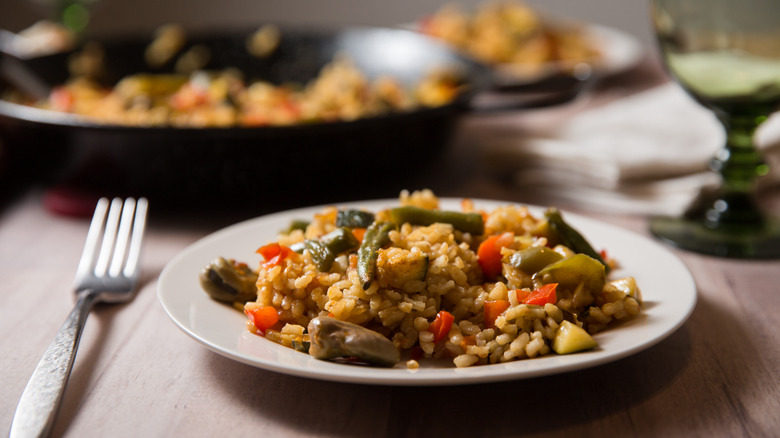
- 2 ½ cups vegetable broth
- ½ pinch saffron threads (about 30 threads)
- 3 tablespoons extra virgin olive oil
- ¼ medium yellow onion, diced
- ½ small green bell pepper, diced
- ½ small red bell pepper, diced
- 2 ounces green beans, stem ends removed and cut into 1–2-inch pieces
- ½ cup fava beans or green peas
- ½ vine-ripened tomato, finely chopped
- ½ small zucchini, chopped
- 2 cloves garlic, minced
- ½ teaspoon paprika
- 1 cup short-grain rice for paella, such as Bomba or Calasparra
- Pour the broth into a medium saucepan and bring it to a boil. As soon as it boils, lower the heat to low and keep it covered until you're ready to use it.
- Ladle ¼ cup of hot broth into a small cup or bowl and add the saffron. Set aside to let it soak.
- Heat the oil on medium, preferably in a paella pan. If you don't have one, you can use a large, heavy-bottomed skillet.
- Add the onion and saute for 3–4 minutes, stirring occasionally.
- Add the green pepper, red pepper, green beans, and fava beans or peas and cook for 5–6 minutes.
- Push the vegetables over to make an empty space in the center of the pan. Place the tomato in the empty space and cook for 5–6 minutes, until reduced.
- Add the zucchini and garlic and stir all the vegetables together. Lower the heat to low and saute for 2–3 minutes.
- Remove the saffron threads from their liquid and pour the liquid into the pan along with the paprika. Quickly stir the mixture on low until the spices are evenly incorporated.
- Add the rice to the pan, spread it out evenly, and let it toast for a minute on low.
- Pour in the hot broth and turn the heat to high. Stir the mixture well, but don't stir it anymore after this step. Remove a spoonful of broth, let it cool, then taste it. Adjust for salt, if necessary.
- Cook the rice on high for 5 minutes.
- Reduce the heat to low and cook for 10–15 minutes, until the rice is al dente, the broth is absorbed, and a crust forms on the bottom. A couple minutes before it's done, check the bottom and adjust the heat to create a crust without burning it.
- Remove the pan from the heat and cover it with a damp cloth for 5 minutes.
- Serve the paella de verduras in the paella pan.
| Calories per Serving | 609 |
| Total Fat | 21.7 g |
| Saturated Fat | 3.1 g |
| Trans Fat | 0.0 g |
| Cholesterol | 0.0 mg |
| Total Carbohydrates | 93.9 g |
| Dietary Fiber | 5.2 g |
| Total Sugars | 7.4 g |
| Sodium | 67.0 mg |
| Protein | 11.3 g |
